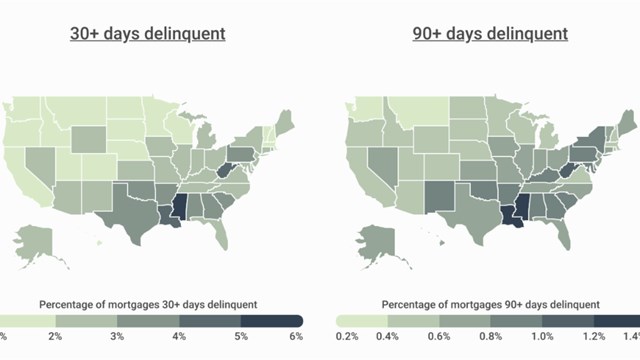The coronavirus crisis has forced many unwelcome changes on households around the world—but it has also allowed or inspired some to make lifestyle choices that were impractical or otherwise out of reach before. One such choice has been to acquire a pet. With travel restricted, and working and schooling largely happening at home, households across the country decided that if there was ever a time to add a furry (or feathered, or scaly) friend to the family, this was it.
But for the 74 million Americans who live in communities managed by homeowners associations or cooperative corporations, according to estimates by the Community Associations Institute (CAI), bringing a pet home involves considerations that those in detached, single-family homes don’t have to contend with. For one thing, many communities simply prohibit pets altogether. Of those that do welcome pets, most have rules—which residents agreed to follow upon becoming a unit owner or shareholder—limiting the species, breeds, sizes, or number of animals residents can harbor in their homes, as well as registration requirements and rules about where the pets are allowed to be on the property. And it’s a given that no pet may interfere with the habitability or quiet enjoyment of their neighbors’ homes.
Along with the rules, there are practical considerations for would-be pet owners, too. In many multifamily communities, having a pet—especially one that needs to go out several times a day like a dog—requires taking that animal through the property’s common areas: the hallways, lobbies, elevators, vestibules, outdoor paths, and so forth. With the ongoing pandemic keeping people at home, that means more interactions between pets, their owners, and their neighbors. An unruly or aggressive pet in an enclosed space (like an elevator or stairwell) is a big problem; it’s also problematic for someone who’s highly allergic to fur or dander. And while vaccination rates are improving and mask requirements in common areas are de rigueur, there’s still a pandemic on; many residents are understandably un-thrilled at the prospect of crowded elevators and lobbies full of rambunctious pups and their owners trying to get outside for morning walkies.
Pet, or Emotional Support Animal?
According to managers, attorneys, and boards, claims for special accommodations for emotional support animals (ESAs) have been trending upward in condo associations and co-ops around the country for the last several years, starting around 2015. Jim Yost, owner of Elite Management and Advisory Services, LLC and managing partner of Ocean Property Management Corporation based in Wildwood, New Jersey, says he thinks the uptick may be linked to commercial airlines changing or clarifying their policies around animals riding in the cabin— specifically their distinctions (or lack thereof) between official service animals, ESAs (also known as ‘comfort animals’), and pets. He suspects that different classifications between airlines have resulted in a lot of conflation of terms and willful misuse of the various designations.
First, let’s get those distinctions out of the way. The Americans with Disabilities Act (ADA) defines service animals as dogs (and only dogs as of March 15, 2011, although there are separate provisions for certain miniature horses) that are individually and specially trained to do work or perform specific tasks for people with disabilities in direct relation to those specific disabilities, such as a guide dog for someone with legal blindness, or an alert dog for someone with a seizure disorder. Dogs whose sole function is to provide comfort or emotional support do not qualify as service animals under the ADA. However, multifamily buildings and communities are subject to rules and guidelines of the U.S. Department of Housing and Urban Development (HUD) and the federal Fair Housing Act (FHA). Notably, HUD does include animals that provide emotional support in its definition of “assistance animals,” and distinguishes those animals from “pets” if that support “alleviates one or more identified effects of a person’s disability.”
These laws require housing providers to make “reasonable accommodations” for persons with disabilities in order to enjoy equal and fair use of their housing. A reasonable accommodation might include an exemption to an association’s or corporation’s ‘no pets’ or ‘no dogs’ policy, or a waiving of fees required under a policy that does allow certain animals. An accommodation may be considered unreasonable if it “would impose an undue financial and administrative burden on the housing provider or … would fundamentally alter the nature of the housing provider’s program.” According to HUD, such determinations “must be made on a case-by-case basis” and can take into account factors specific to a given residential situation.
Yost says that there are plenty of examples of people taking undue advantage of this law. “In the associations that have pet prohibitions,” he says, “people have attempted to circumvent them: They bring a pet in, and when they’re caught, claim it’s a service animal. And that poses a problem, because buyers are given the governing documents at time of purchase, including specifically the Pet Prohibition Amendment. So they can’t say they didn’t know.”
According to Heather Stiell, senior counsel with New York City-based law firm Lasser Law Group, the only questions or “proof” that can be asked of a person requesting an accommodation for an assistance animal are for “documentation supporting the existence of the claimed disability, and the need for an emotional support animal to alleviate or assist in that disability.” Such documentation, says Stiell, can include a letter from a licensed mental health professional treating the individual. There is no nationally recognized ESA “registry” or organization that provides an official ESA “designation” or “certification.” (No, not even from the internet.)
Stiell explains that asking inappropriate questions or unduly rejecting a request for an ESA accommodation can open boards up to civil liability and penalties under federal and state anti-discrimination and human rights laws. But by the same token, such requests must be vetted for legitimacy, and approvals only given when the accommodation does not interfere with the housing rights or safety of other residents. As an example, Yost relates how one Southern New Jersey condo board handled a suspicious medical letter submitted as documentation for a resident’s ESA accommodation request: “The board notified the author of the letter that they were submitting the correspondence to the State medical oversight board,” he says. “The author immediately retracted their supporting correspondence, and the request for the emotional support animal was withdrawn.”
Similarly, adds Stiell, whether a pet, an ESA, or a service animal, “If the animal in question were a type of animal that was deemed to be unsafe or unsanitary, either because of a health code limitation, or because the animal was disruptive or dangerous or caused a lot of damage,” then it is no long considered “reasonable” to accommodate that animal. “Buildings are not required to accept an animal if it would pose an undue burden to the building, or to the residents of the building.”
Aside from having a valid, medically recommended claim for an animal companion, Yost strongly advises anyone seeking ESA accommodations to make that claim, provide the proper documentation, and receive board approval before obtaining the animal. Even associations and corporations with longstanding pet-friendly policies typically require some kind of board notification and documentation (municipal licensure, updated vaccinations, and in some cases proof of spaying or neutering) before any animal can reside on the property, including pets, ESAs, and service animals.
Along with the surge in requests (legitimate or not) for ESAs, housing professionals say they’ve also noticed a misconception circulating among owners once their requests are approved: many seem to think the established rules about pets in their building or community don’t apply to them and their ESAs.
“There have been issues with people not realizing that their service [or emotional support] animals still have to abide by the pet policies in the building,” says Alison Phillips, CMCA, AMS, CAM, vice president of multifamily and commercial real estate at FirstService Residential based in Massachusetts. “If somebody is going to have an emotional service animal, they have to fully understand what’s expected of them. They have every right to get one, but they do have the responsibility that comes with it as well.”
Pets Can Make Great Neighbors
It may be that the rise in ESA accommodation requests may eventually plateau, since buildings and communities throughout the country are increasingly pet friendly. For some that may mean amending rules to allow animals that were previously forbidden, while for others it may include adding pet-specific amenities to their offerings. There are a number of reasons for this reconsideration. For one thing, many building owners and operators understand that there is an underlying economic incentive to allowing pets; the National Association of Realtors® (NAR) found that pet-friendly properties are more profitable for investors, and a three-year study by real estate appraiser Jonathan Miller of New York-Based Miller Samuel found that as of September 2015, the average sale price of an apartment in a pet-friendly building in New York is $2.18 million, versus $1.03 million for no-pets buildings, and $830,000 for buildings barring dogs. (He notes, however, that the price differentials could be attributed to other factors, such as the size, type, and location of buildings with more liberal pet policies). Statistics from the following year attributed to the American Pet Products Association (APPA) showed that an overwhelming majority—68%—of U.S. households had a pet.
That number has undoubtedly increased since the start of the coronavirus pandemic in March 2020. According to the American Society for the Prevention of Cruelty to Animals (ASPCA), 23 million American households have acquired a pet during the COVID-19 crisis. Given the mental and emotional toll that the pandemic has taken on all of us, it could be argued that these are indeed emotional support animals, whether specifically ESA-identified or not. The organization’s website reminds us that “pets provide companionship, comfort, consolation, and a sense of security. They have positive impacts on us at every stage of life—numerous studies have shown that pet owners live longer, visit doctors less often, recover from illness more quickly, and have more positive outlooks than those who do not have pets.”
Some states are even wading into the issue. Nevada for instance recently passed legislation to prevent common interest development communities governed by HOAs from restricting pets, and other states and municipalities are doing the same. A federal bill introduced into the U.S. House of Representatives in 2021 seeks to eliminate the breed and size restrictions on dogs in public housing, “allowing families to access affordable and stable housing while keeping their pets with them,” explains the ASPCA, in addition to keeping those animals out of overcrowded, under-resourced shelters and rescue centers. (The bill would still allow housing authorities to exercise discretion in restricting potentially dangerous individual animals, but would remove housing barriers for thousands of responsible pet owners.)
“Throughout the country,” says an ASPCA representative, “this stressful period has motivated many people to foster and adopt animals—as well as further cherish the pets already in their lives. We’re seeing that pets are incredible sources of love and companionship in our lives and bring more comfort than ever during these stressful times…We rely on them as much as they rely on us.”
As pet—and especially dog—ownership has increased nationwide, condominiums, co-ops, and HOAs should make sure to review their pet policies, communicate them clearly and often to both new and old residents, and consider establishing procedures for reviewing reasonable accommodation requests for ESAs. Each of these requests should be considered individually and according to the relevant facts of the situation, and with the guidance of legal counsel. And residents with dogs—or those considering getting one—should remember that they are bound by their building’s or association’s policies, even if the animal assists with a physical, mental, or emotional disability. After all, a responsible dog owner is the greatest companion for man’s best friend.
Darcey Gerstein is Associate Editor and a Staff Writer for CooperatorNews.










Leave a Comment